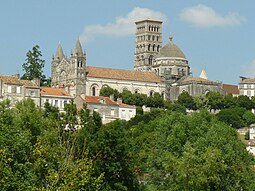Roman Catholic Diocese of Angoulême
Catholic diocese in France From Wikipedia, the free encyclopedia
Catholic diocese in France From Wikipedia, the free encyclopedia
The Diocese of Angoulême (Latin: Dioecesis Engolismensis; French: Diocèse d'Angoulême) is a Latin diocese of the Catholic Church in France. Originally erected in the 3rd century, the episcopal see is the Angoulême Cathedral. Comprising the département of the Charente, the diocese had traditionally been suffragan to the Archbishopric of Bordeaux, under the old régime as well as under the Concordat, but since 2002 is suffragan to the Archdiocese of Poitiers.
Diocese of Angoulême Dioecesis Engolismensis Diocèse d'Angoulême | |
|---|---|
 | |
| Location | |
| Country | France |
| Ecclesiastical province | Poitiers |
| Metropolitan | Archdiocese of Poitiers |
| Coordinates | 45.65°N 0.15°E |
| Statistics | |
| Area | 5,972 km2 (2,306 sq mi) |
| Population - Total - Catholics | (as of 2022) 352,015 (est.) 269,000 (est.) (76.4%) |
| Parishes | 29 |
| Information | |
| Denomination | Roman Catholic |
| Sui iuris church | Latin Church |
| Rite | Roman Rite |
| Established | 3rd Century |
| Cathedral | Cathedral of St. Peter in Angoulême |
| Patron saint | Saint Ausonius of Angoulême Saint Cybard |
| Secular priests | 46 (Diocesan) 8 (Religious Orders) 13 Permanent Deacons |
| Current leadership | |
| Pope | Francis |
| Bishop | Hervé Gosselin |
| Metropolitan Archbishop | Pascal Wintzer |
| Bishops emeritus | Claude Dagens |
| Map | |
 | |
| Website | |
| Website of the Diocese | |
In 2022, in the Diocese of Angoulême there was one priest for every 4,981 Catholics.
This section needs expansion. You can help by adding to it. (December 2016) |
Its first bishop was Ausonius, a disciple, it is said, of Saint Martial. According to Gregory of Tours Martial preached the gospel in Limoges about the year 250; the Limousin traditions, as set down by the chronicler Adhémar de Chabannes, maintain that Martial was the immediate disciple of Saint Peter. According to the latter opinion St. Ausonius was a bishop of the first century; according to the former, of the third century. At least one modern historian believes it likely that Ausonius lived even later, in the 4th century.[1] His cult, however, does not appear until the end of the tenth century.[2]
The Gallia Christiana lists St. Salvius, honoured as a martyr at Valenciennes, as a Bishop of Angoulême. The 1913 Catholic Encyclopedia, however, considers him to have been only a missionary bishop of the eighth century.[3] In the list of the Bishops of Angoulême is found the name of the poet Octavien de St. Gelais (1494–1502).
The religious monuments of the province of Angoumois are remarkable for their admirable Romano-Byzantine façades. The most beautiful of them is St. Peter's Cathedral at Angoulême. The original cathedral was dedicated to Saint Saturninus, but it was destroyed by the Arian Visigoths. After the defeat of Alaric II in 507, King Clovis had his chaplain Aptonius made bishop and had the cathedral rebuilt and named in honor of Saint Peter.[4] It was consecrated around 570, according to tradition by Saint Germain, Bishop of Paris. The cathedral was ravaged again, this time by the Normans, in the middle of the ninth century. It was rebuilt by Bishop Grimoard and dedicated in 1017. The present edifice is the work of Bishop Gérard II de Blaye, the Papal Legate, ca. 1109–1120.[5] The cathedral was administered by a Chapter, composed of a Dean, the Archdeacon, the Treasurer, and twenty-one Canons. There were also a Cantor and Scholasticus, but they did not have a vote in Chapter unless they were also Canons.[6]
The memory of a wealthy and famous Augustinian abbey, founded in 1122, is kept alive by its ruins at Couronne, near Angoulême.
In 1236, the Jewish community of Angouleme, along with those in Anjou, Poitou, and Bordeaux, was attacked by crusaders. 500 Jews from these communities chose conversion and over 3000 were massacred. Pope Gregory IX, who originally had called the crusade, was outraged about this brutality and criticized the clergy of the diocese of Angoulême for not preventing it.[7]
Seamless Wikipedia browsing. On steroids.
Every time you click a link to Wikipedia, Wiktionary or Wikiquote in your browser's search results, it will show the modern Wikiwand interface.
Wikiwand extension is a five stars, simple, with minimum permission required to keep your browsing private, safe and transparent.